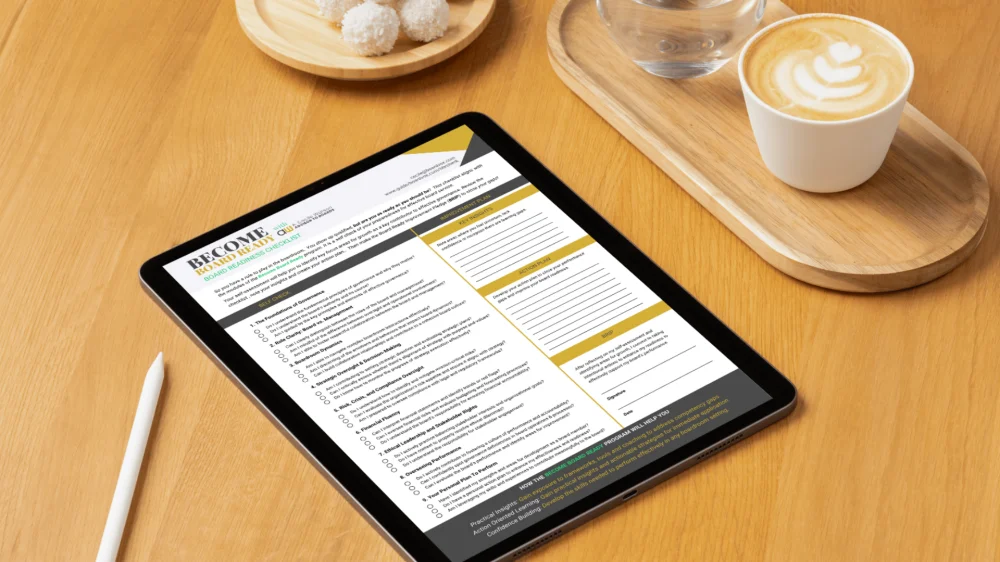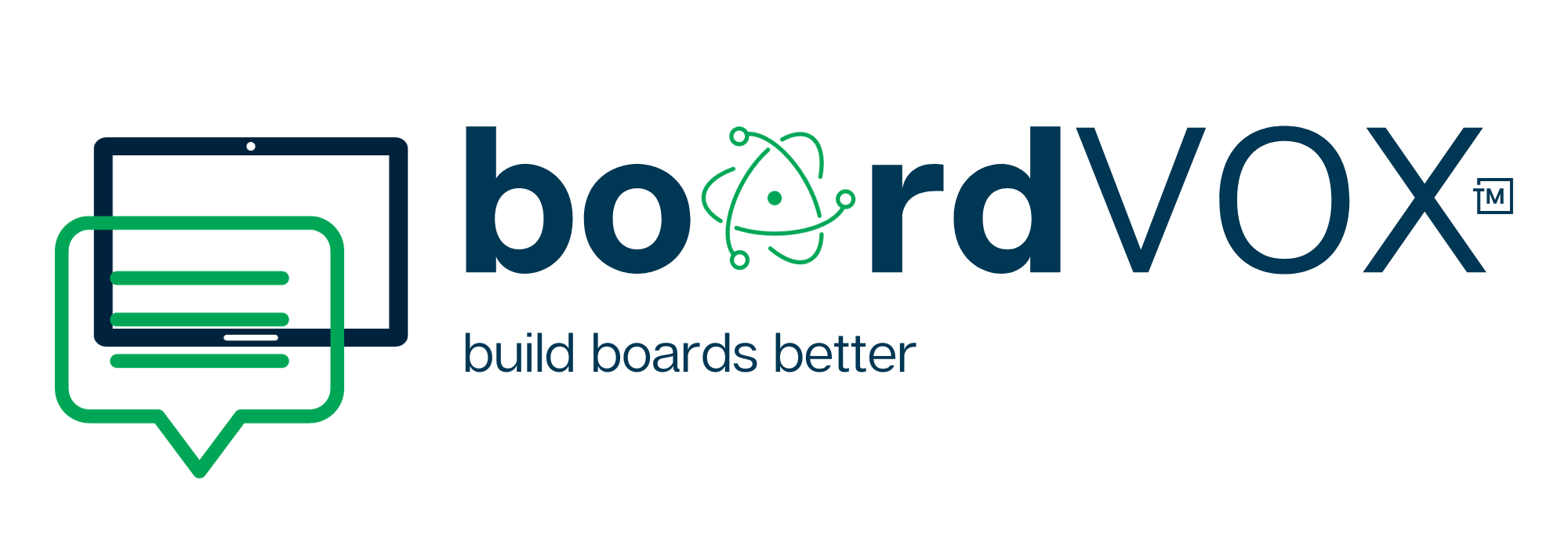Empowering
Good Governance Through You
... one board at a time
Download the Checklist and take the first step toward joining the Become Board Ready Program.
Download the Checklist and take the first step toward joining the Become Board Ready Program.
How we help
We are the
Voice, Tone and Expression of Good Governance
helping organizations to realize their full potential
by educating, informing, and supporting boards,
directors, and c-suite leaders
with the training, tools and services
to create the best value for today and the future.
How we help
We are the Voice, Tone and Expression of Good Governance
helping organizations to realize their full potential
by educating, informing, and supporting boards, directors, and c-suite leaders
with the training, tools and services to create the best value for today and the future.

Board & Director
Training
We support directors and c-suite leaders to be their best in the boardroom with coaching, workshops & online training.

Board Performance
Tools
We administer board evaluations, board improvement plans and provide technology to support improving board performance.

Board Operating
Support Services
We support boards to become more effective by offering services such as retreat facilitation, policy templates and admin tools.
Let's reimagine the future of board development.
We believe that every director holds the key to unlocking extraordinary boardroom potential. We also believe that the power to unlock sustainable economic growth resides with people just like you right there in the boardroom. Reputational risks are at an all time high. And board service is important work deserving of the best hearts and minds.
That's why we're making governance easier for smarter boards by helping directors embrace their profound responsibility and forge a path of independent thinking, ethical leadership and championing good governance.
Become Board Ready
This checklist is your entry point to the
Become Board Ready Program ...a guide designed to empower directors and aspiring board members to excel in their governance roles.
Empower yourself to:
Elevate Your Governance Expertise: Master the key principles that drive effective board leadership.
Strengthen Board Dynamics: Foster alignment, trust, and a shared understanding in the boardroom.
Confidently Navigate Your Role: Clarify your responsibilities and deliver value with confidence.
Enhance Strategic Oversight: Stay focused on purpose, accountability, and long-term success.


This checklist is aligned with the proven modules of our Become Board Ready program, so you can start assessing and addressing your readiness immediately.
Complete the form and you'll receive the Board Readiness Checklist directly in your mailbox.
Privacy Disclaimer:
We respect your privacy. The information you provide will only be used to deliver your checklist and occasional updates about governance insights and resources. We will never spam you, sell, or share your information with third parties.

RED FLAGS IN THE BOARDROOM CHECKLIST
Add this to your Board Engagement Toolkit to have a handy guide empowering you to:
Identify potential governance risks early
Be vigilant and avoid corporate governance failures.
Uphold the highest standards of transparency and ethics.


Women on Boards: Why the Supreme Court’s Ruling Is Not About the Culture War on Womanhood
In a recent CNN interview, a political pundit said something that caught my attention:
“The Supreme Court isn’t last because they’re right. They’re right because they’re last.”
That sentiment has stayed with me. It reminds me that what is declared “right” in law often comes down to who has the final say. Authority, not always agreement, settles the matter.
Today, April 16th, the UK Supreme Court ruled that, for the purposes of Scotland’s Gender Representation on Public Boards Act, the term “woman” refers to sex as recorded at birth. It does not include gender identity, even when legally recognized through a Gender Recognition Certificate.
Many have weighed in, celebrating what they consider to be a final legal ruling on who is a woman and who isn’t. And in doing so, they are misrepresenting what the Supreme Court actually ruled.
As someone who works in governance, I’ve been reflecting on what this ruling really means … and what it doesn’t.
What was this case really about?
The 2018 Scottish law was introduced to address the persistent underrepresentation of women in public leadership roles. The goal was clear: bring gender balance to public boards by ensuring at least 50% of non-executive roles were held by women.
The Scottish Government interpreted “woman” in the guidance to include transgender women with Gender Recognition Certificates. That interpretation was challenged in court by the campaign group For Women Scotland.
Let’s be honest—this challenge wasn’t brought to explore the intent of the Act. It was brought because the claimants fundamentally rejected the idea that trans women should be included in policies designed to advance women’s representation.
The real question posed to the Court wasn’t only about policy design. It was about legitimacy. Could trans women be lawfully counted in a measure intended to correct exclusion based on sex assigned at birth?
What the Court ruled
The Court didn’t erase anyone’s identity. It didn’t deny the right of transgender individuals to legal recognition or protection. In fact, it confirmed that transgender people are protected under the Equality Act 2010, through the characteristic of “gender reassignment.”
But it did say this:
If a law is written to address the underrepresentation of people who were excluded because they were born female, then the scope of that law must stay aligned with that purpose. Including individuals who were not subject to that specific form of exclusion would change the nature of the remedy.
This was not a social or moral verdict on gender identity. It was a legal interpretation grounded in legislative purpose.
What many are taking away … and why it’s worth pausing there
If you scan LinkedIn or public commentary, you’ll find a common narrative gaining traction. The sentiment goes something like this: The Court has now confirmed that trans women are not women. Even with a Gender Recognition Certificate, the law doesn’t recognize them as such.
Some see this as a return to clarity … or as one contributor put it, “sanity prevailing.”
But that framing misses the mark.
The Court didn’t weigh in on identity or make broad declarations about personhood. It answered a very narrow legal question: Can a policy created to correct sex-based exclusion be satisfied by including individuals who weren’t historically subject to that exclusion?
The answer, legally, was no.
And for those of us working in governance, the clarity matters. Not because it settles a cultural debate, but because it sharpens the policy intent.
Why this matters in governance
This ruling is more than a legal moment. It is a governance one.

The power of a policy lies in being tightly focused on solving the problem it was created to fix. When they stretch too far in an effort to satisfy everyone, they risk serving no one effectively.
Inclusion and fairness matter. But fairness starts with clarity.
The original purpose of the Scottish law was to increase representation for people excluded from leadership because they were born female. The Court ruled that to preserve the integrity of that purpose, the legal definition must match the group the policy was created to support.
That is not an act of exclusion. It is an act of alignment.
What about trans representation?
Trans individuals deserve representation. That truth stands. Their experiences and perspectives enrich the work of leadership, especially in sectors that intersect with identity, rights, and public service.
But governance requires us to recognize that not every equity issue can be addressed by the same policy. Trans representation needs its own thoughtful approach shaped by the realities and barriers they face. We do not advance equity by collapsing distinct challenges into one.
We advance equity when we stay honest about the problem … and bold enough to design a solution that fits.
A final thought on authority in governance
In law, authority brings closure. The Supreme Court has ruled. The legal interpretation stands.
This case may have centered on how the law defines “woman” for the purpose of a specific policy. But its implications reach much further.
For those of us who lead, who govern, and who shape policy, this is a moment to reflect ...not just on what was ruled, but on how decisions like this highlight the importance of clarity, purpose, and intent in complex spaces.
In governance, authority gives you the right to decide. But the weight of that decision must be carried by trust, by focus, and by alignment with the problem you're trying to solve. Without that, even well-intentioned policies can lose their legitimacy.
The ruling may bring legal closure. But it also invites a deeper kind of accountability …
Are we solving the problem we set out to solve?
Are we being clear about who the policy is designed to support?
And are we staying faithful to the purpose that gave rise to it in the first place?
When representation is pursued without clarity, it risks creating more confusion than progress. And when governance becomes confused, it stops serving the people it was built to protect.
Let’s share and keep it real!
#Governance #WomenOnBoards #Representation #TransRights #LeadershipWithPurpose #PolicyDesign #ClarityInGovernance #EquityInGovernance #GovernanceEdge #BoldLeadership #EthicalGovernance #CorporateGovernance #BecomeBoardReady
Enjoyed this article? Subscribe to never miss an issue.
Drop me a note and share your best board leadership stories.
Stay tuned for more perspectives on bold leadership and ethical governance insights. And if you haven't already, be sure to subscribe so you never miss a post. Together, we're set to build better boards and build boards better by reshaping the landscape of boardroom leadership, one director at a time.
🌐💼 #BecomeBoardReady #strategy #BoardDevelopment #CorporateGovernance #GoodGovernance #BoldLeadership #EthicalGovernance #BoardPerformance #boardvox 🤝🔍
Know someone who might be interested in this blog? Please be sure to share it with them.
Also be sure to follow our boardVOX WhatsApp channel here. It is Especially for directors, c-suite leaders, corporate secretaries and all interested in good governance.
YES, YES ...I GET IT
This is exactly what I need right now.
I'm seeking a network of professionals who understand the challenges of the boardroom.
I want to elevate my leadership and have a real impact in the boardroom.
Continuous learning is crucial in our field, and I'm eager to stay ahead.
I'm sold on good governance and excellence.
Connecting with like-minded professionals in the industry is a top priority for me.
I'm committed to being a positive catalyst for change in the organizations I serve.
I believe in the power of good governance to shape the future of business and communities.
I want to learn how to steer governance processes positively and leave a lasting legacy.
It's time for my expertise and leadership to create a powerful impact in the boardroom.
IF THIS SOUNDS LIKE YOU, THEN DIVE RIGHT IN
Join Our Movement As
A Partner In Good Governance.
We're here to help you avoid the SHOULD'VEs and COULD'VEs in fulfilling your responsibilities as a director.
© 2024 A. Cecile Watson | boardVOX, All Rights Reserved


